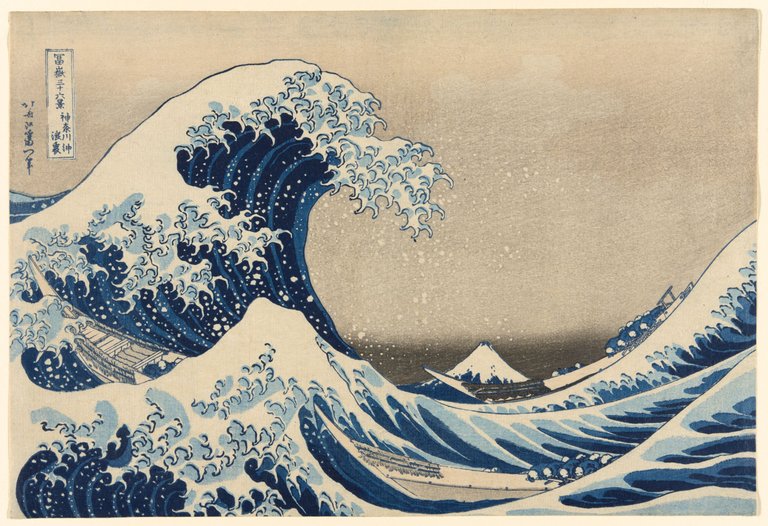Hokusai’s Great Wave: More Than Just a Meme
It's no secret that I love Japanese woodblock prints. I usually include them in my haiku posts and even in some of my other posts. There is something very striking about even the most simple of them. Today I want to talk about one of these. The most famous of them all: Hokusai's Great Wave.

Few images from Japan are as instantly recognizable as Katsushika Hokusai’s The Great Wave off Kanagawa. Even people who’ve never heard the name Hokusai, or the term ukiyo-e, have seen it somewhere — on T-shirts, album covers, coffee mugs, or even emoji keyboards. Its curling spray has become a universal shorthand for “Japanese art.” But reducing it to pop iconography risks losing the richness of what it actually represents.
The wave was published around 1831 as part of Hokusai’s Thirty-Six Views of Mount Fuji. By then, Hokusai was in his seventies, having spent a lifetime experimenting with style and subject matter. That the work most associated with him came so late in life is striking—a reminder that an artist’s peak need not arrive in youth.
At first glance, the drama is obvious: fragile fishing boats tossed under the weight of a monstrous wave, Mount Fuji serene in the distance. The juxtaposition is central. Nature is violent, unpredictable, and overwhelming; human endeavor is small and transient. Yet Fuji, sacred and immovable, remains a calm anchor in the composition.
While undeniably Japanese in its woodblock execution, the wave also reflects foreign influence. Hokusai had access to imported Dutch prints, and one can see a hint of Western perspective in the way the wave curves toward the viewer, threatening to crash right out of the paper. The deep Prussian blue pigment, newly available through trade, gives the print its vivid depth—something unachievable with earlier Japanese dyes.
It’s tempting to view the wave purely as aesthetic spectacle, but its endurance lies in metaphor. For some, it embodies the timeless tension between man and nature; for others, it foreshadows modern anxieties—technology, globalization, forces beyond our control. That the image remains open to reinterpretation is part of its genius.
Ironically, when Hokusai made this print, it was just one in a series, sold cheaply to common people. Today, it hangs in museums worldwide and circulates endlessly online.[1] Its journey from mass-produced ephemera to cultural icon mirrors the very waves it depicts: movement, transformation, and sheer unstoppable force.
Here it is again:


Do we still see the Great Wave as Hokusai intended, or has its omnipresence dulled its impact? Perhaps both. The wave has become both artwork and symbol—timeless in form, yet ever-shifting in meaning, just like the sea itself.
❦
 |
David is an American teacher and translator lost in Japan, trying to capture the beauty of this country one photo at a time and searching for the perfect haiku. He blogs here and at laspina.org. Write him on Bluesky. |
That irony applies to all of ukiyo-e. They were in many ways an art form for the working class — cheaply made, with artists often poor themselves. Yet now many, if not most, of those old woodblock prints command huge sums from collectors. ↩
I've noticed this on T-shirts around here and never thought I'd come across it on hive. Thanks for sharing!
You're welcome!
Do people still practice this type of art? I'd be interested in seeing how that works. I remember doing a carving when I was in school, but we only mounted it on a wood block, the medium we used was some kind of flat clay or something. Just throw me a Youtube video link or something :)
Yep, it's exactly that. They make a carving in a wood block, then use that block to make prints. It is still practiced today. It's no longer considered cheap art for the working class, but is a bit higher end and expensive, but it's very much still practiced. I'll go and look for a video and send it to you.
Okay that is cool. It kind of sounds like what we did in school, but I don't think we carved right into the wood.
Hello @dbooster, the artwork you're showing has caused me mixed feelings. On one hand, it sympathizes with the efforts the crews of these vessels must be undertaking in those stormy seas, and also with the fear they may be experiencing due to the risk to their lives. On the other hand, I found a silver lining in noticing that there's solid ground. This work has made me think about difficult situations in life and how there's always a chance to overcome them. Greetings. Thanks for the post!